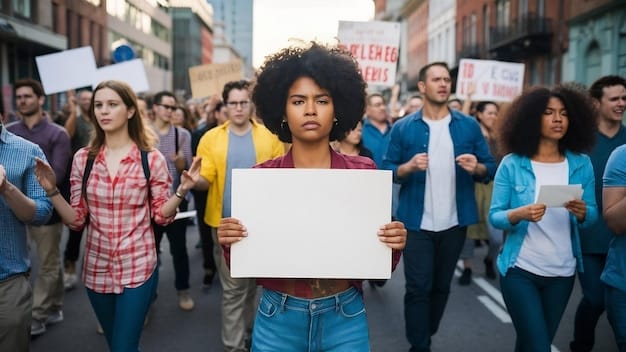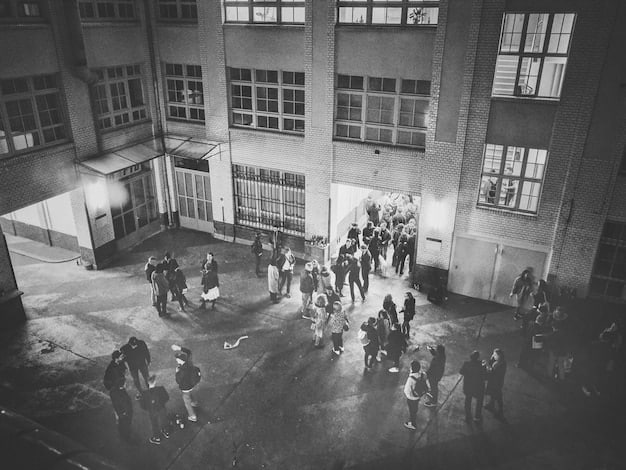Social Justice Protests: Examining the Projected 15% Increase

Examining the projected 15% increase in social justice protests involves analyzing a complex interplay of factors, including heightened awareness of inequality, political polarization, and the pervasive influence of social media in mobilizing collective action.
The world is witnessing a surge in social justice movements, with projections indicating a significant 15% increase in protests. This begs the question: what’s fueling the rise in these movements? We aim to dissect the multifaceted causes behind this upswing. Let’s delve into the intricate dynamics driving this global phenomenon, highlighting key factors propelling individuals into the streets to voice their demands for change. The urgent conversation around examining the projected 15% increase in social justice protests: what’s fueling the rise? is more crucial than ever.
Understanding the Landscape of Social Justice Protests
Before delving into the reasons behind the projected increase, it’s essential to understand what constitutes a social justice protest. These protests are manifestations of collective action, aimed at challenging systemic inequalities and advocating for a more just and equitable society. Understanding their nature and scope is vital.
Social justice protests encompass a wide range of issues, from racial equality and gender rights to environmental protection and economic justice. They vary in scale, tactics, and objectives, reflecting the diverse concerns of the communities they represent. Let’s start by understanding a few key facets.
Historical Context of Social Justice Movements
Throughout history, social justice movements have played a crucial role in shaping societies and driving progress. From the Civil Rights Movement in the United States to the anti-apartheid struggle in South Africa, these movements have challenged oppressive systems and paved the way for greater equality.
The Role of Technology and Social Media
In the digital age, technology and social media have become powerful tools for social justice movements. They facilitate communication, mobilization, and awareness-raising, enabling activists to connect with wider audiences and organize protests more effectively. These tools have become essential.

- Enhanced Communication: Social media platforms allow activists to communicate instantly and coordinate actions in real-time.
- Wider Reach: Social media enables movements to reach broader audiences, transcending geographical boundaries.
- Amplified Voices: Technology empowers marginalized communities to share their stories and experiences, amplifying their voices in the public sphere.
Understanding the landscape of social justice protests requires recognizing their historical roots, diverse forms, and the role of technology in amplifying their impact. It is a multifaceted topic with many layers.
Economic Inequality and the Frustration Factor
One of the primary drivers of social justice protests is the widening gap between the rich and the poor. Economic inequality fuels frustration and resentment, particularly among marginalized communities who bear the brunt of systemic disadvantages. Let’s look at how economic inequality contributes to rise.
Rising income inequality, coupled with stagnant wages and limited opportunities, creates a sense of injustice that drives people to the streets. The perception that the economic system is rigged in favor of the wealthy elite further exacerbates this frustration.
The Impact on Marginalized Communities
Marginalized communities, including racial and ethnic minorities, women, and LGBTQ+ individuals, often face additional barriers to economic mobility. Discrimination in hiring, unequal pay, and lack of access to resources contribute to their economic vulnerability and fuel their participation in social justice protests.
The Role of Globalization and Automation
Globalization and automation have reshaped the economic landscape, leading to job displacement and wage stagnation in many sectors. These trends have disproportionately affected working-class communities, contributing to their economic insecurity and fueling their discontent with the status quo.

- Job Displacement: Automation and outsourcing lead to job losses in manufacturing and other sectors.
- Wage Stagnation: Real wages have remained stagnant for decades, despite rising productivity.
- Limited Opportunities: Lack of access to education, healthcare, and affordable housing restricts economic mobility for marginalized communities.
Economic inequality serves as a potent catalyst for social justice protests, particularly when coupled with systemic discrimination and limited opportunities. Addressing this issue requires comprehensive policies that promote economic fairness and social inclusion.
Political Polarization and the Erosion of Trust
In many countries, political polarization has reached alarming levels, eroding trust in institutions and exacerbating social divisions. This polarization fuels social justice protests by creating a climate of animosity and distrust, where dialogue and compromise become increasingly difficult. Finding common ground is harder than ever.
As political divides deepen, individuals become more entrenched in their beliefs, less willing to engage with opposing viewpoints, and more likely to resort to protest as a means of expressing their grievances. The rise of partisan media and echo chambers on social media further amplifies this polarization.
The Impact on Policy and Governance
Political polarization can paralyze government, making it difficult to address pressing social and economic issues. When policymakers are unable to find common ground, frustration grows, and people turn to protest as a way of demanding action.
The Role of Identity Politics
Identity politics, while playing a crucial role in giving voice to marginalized communities, can also contribute to political polarization. When political discourse becomes centered on identity-based grievances, it can deepen divisions and make it harder to build broad-based coalitions for social change.
- Decreased Civility: Political polarization leads to increased incivility and hostility in public discourse.
- Gridlock in Government: Polarization can paralyze government, preventing meaningful policy reforms.
- Distrust in Institutions: Political polarization erodes trust in government, media, and other institutions.
Political polarization acts as a major catalyst for social justice protests, exacerbating existing inequalities and making it more difficult to address pressing social and economic issues. It necessitates efforts to bridge divides, promote dialogue, and restore trust in institutions.
Social Media: Fueling Awareness and Mobilization
As previously mentioned, social media has emerged as a powerful tool for social justice movements, facilitating awareness-raising, mobilization, and collective action. Its ability to connect individuals and amplify voices has revolutionized the way protests are organized and sustained. It’s the new town square.
Social media platforms provide activists with a platform to share information, organize events, and connect with like-minded individuals. Hashtags, viral videos, and online campaigns can quickly mobilize support for social justice causes and put pressure on decision-makers.
The Power of Hashtags and Viral Content
Hashtags like #BlackLivesMatter and #MeToo have become symbols of social justice movements, uniting individuals around common causes and amplifying their messages on a global scale. Viral videos and images can capture public attention and spark outrage, leading to increased activism and policy changes.
The Challenges of Online Activism
While social media offers many benefits for social justice movements, it also presents challenges. Online activism can be superficial or performative, lacking the depth and commitment of offline engagement. Moreover, social media platforms can be used to spread misinformation, harass activists, and suppress dissent.
- Rapid Information Dissemination: Social media allows for the rapid dissemination of information about social justice issues.
- Global Connectivity: Social media connects activists and supporters across geographical boundaries.
- Increased Visibility: Social media can increase the visibility of social justice movements and their demands.
Social media plays a vital role in fueling awareness and mobilization for social justice causes, offering both opportunities and challenges. It requires activists to navigate the digital landscape strategically, leveraging its power while mitigating its risks.
Environmental Concerns and Climate Activism
Environmental concerns, particularly those related to climate change, have emerged as a major driver of social justice protests. Climate activists are demanding urgent action to address the environmental crisis, holding governments and corporations accountable for their role in exacerbating the problem. There has never been more urgency.
From mass demonstrations to civil disobedience campaigns, climate activists are using a range of tactics to raise awareness and pressure policymakers to adopt more ambitious environmental policies. They argue that climate change disproportionately affects marginalized communities, exacerbating existing inequalities and injustices.
The Impact on Indigenous Communities
Indigenous communities are particularly vulnerable to the impacts of climate change, as their traditional lands and livelihoods are threatened by rising sea levels, extreme weather events, and resource extraction. Indigenous activists are at the forefront of the climate justice movement, demanding recognition of their rights and protection of their ancestral territories.
The Rise of Youth Activism
Young people are increasingly concerned about the future of the planet and are taking to the streets to demand climate action. Led by activists like Greta Thunberg, youth climate strikes have mobilized millions of people worldwide, putting pressure on governments to address the climate crisis with greater urgency.
- Increased Awareness: Climate activism raises public awareness about the urgency of addressing climate change.
- Policy Influence: Climate protests put pressure on policymakers to adopt more ambitious environmental policies.
- Solidarity Building: Climate activism builds solidarity among diverse communities facing the impacts of climate change.
Environmental concerns and climate activism are driving a significant portion of social justice protests, highlighting the intersectionality of environmental issues with social and economic justice. This requires comprehensive solutions that address both the environmental crisis and the underlying inequalities that exacerbate its impact.
Government Responses and Repression
Government responses to social justice protests vary widely, ranging from dialogue and negotiation to repression and violence. The way governments respond to protests can either de-escalate tensions or further inflame them, shaping the trajectory of social movements. Let’s explore a few of the ways.
In some cases, governments engage in constructive dialogue with protesters, addressing their grievances and working towards negotiated solutions. In other cases, governments resort to heavy-handed tactics, using law enforcement to suppress protests and silence dissenting voices.
The Use of Force and Surveillance
The use of force against protesters, including tear gas, rubber bullets, and physical violence, can have a chilling effect on freedom of expression and assembly. Surveillance of activists and online monitoring can further stifle dissent and undermine social movements.
The Criminalization of Protest
Some governments have enacted laws that criminalize protest activity, making it more difficult for activists to organize and participate in demonstrations. These laws often target specific forms of protest, such as blocking traffic or disrupting public order, and can be used to silence dissent under the guise of maintaining public safety.
- Increased Tensions: Repressive government responses can escalate tensions and lead to further protests.
- Erosion of Trust: Heavy-handed tactics erode trust in government and law enforcement.
- Suppression of Dissent: Criminalization of protest stifles freedom of expression and assembly.
Conclusion
Examining the projected increase in social justice protests requires a nuanced understanding of the complex interplay of economic, political, social, and environmental factors. From economic inequality and political polarization to social media mobilization and government responses, these factors interact in intricate ways, shaping the trajectory of social movements and protests. Addressing the root causes of social unrest requires comprehensive policies that promote economic fairness, social inclusion, and environmental sustainability, while safeguarding the fundamental rights of freedom of expression and assembly.
| Key Point | Brief Description |
|---|---|
| ⚖️ Economic Inequality | Widening wealth gap fuels frustration. |
| 🗳️ Political Polarization | Erosion of trust in institutions. |
| 📱 Social Media | Amplifies awareness and mobilization. |
| 🌍 Environmental Concerns | Climate activism drives social justice protests. |
Frequently Asked Questions
Key factors include economic inequality, political polarization, social media mobilization, environmental concerns, and government responses to these issues.
The widening gap between the rich and poor creates frustration, especially among marginalized communities facing systemic disadvantages.
Social media helps activists raise awareness, mobilize support, and connect with others, but also poses challenges regarding misinformation.
Government responses can either de-escalate tensions through dialogue or inflame them through repression, shaping the movement’s trajectory.
Climate change disproportionately harms marginalized communities, exacerbating inequalities, making environmental activism part of social justice.
Conclusion
In conclusion, The projected 15% increase in social justice protests highlights a global surge in activism driven by a complex interplay of factors. Understanding these dynamics is crucial for addressing the root causes of social unrest and fostering a more just and equitable society. While challenges persist, the collective action of individuals and communities remains a powerful force for positive change.





